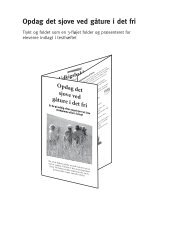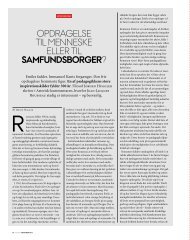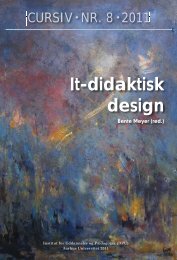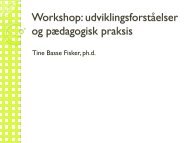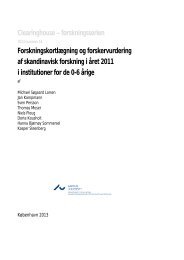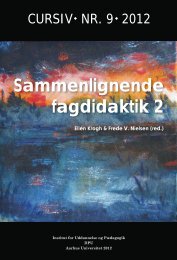Emotioner og læring
Emotioner og læring
Emotioner og læring
Create successful ePaper yourself
Turn your PDF publications into a flip-book with our unique Google optimized e-Paper software.
Litteratur<br />
Bless, H. (2000): The Interplay of Affect and C<strong>og</strong>nition i Forgas, J.P. (red.): Feeling and Thinking – The Role of Affect in<br />
Social C<strong>og</strong>nition, Cambridge University Press, New York<br />
Cannon, W.B. (1927): The James-Lange theory of emotion: a critical examination and an alternative theory. American<br />
Journal of Psychol<strong>og</strong>y, 39, 106-124<br />
Christie, I. C. & Friedman, B. H. (2004): Autonomic specificity of discrete emotion and dimensions of affective space: a<br />
multivariate approach, International Journal of Psychophysiol<strong>og</strong>y, 51 (2), 143-153<br />
Damasio, A. R. (1999): The Feeling of What Happens: Body and Emotion in the Making of Consciousness, Harcourt Brace<br />
& Company, New York<br />
Damasio, A.R. (1994): Descartes Error - Emotion, Reason, and the Human Brain, G.P. Putnam’s Sons, New York<br />
Ekman, P. (1999): Basic Emotions i Dalgleish, T. & Power, M.J. (red.): Handbook of C<strong>og</strong>nition and Emotion, John Wiley &<br />
Sons, Chichester<br />
Isen, A.M. (1999): Positive Affect i Dalgleish, T. & Power, M.J. (red.): Handbook of C<strong>og</strong>nition and Emotion, John Wiley &<br />
Sons, Chichester<br />
James, W. (1884): What is an Emotion, Mind, 9, 188-205<br />
Lazarus, R.S. (1999): The C<strong>og</strong>nition-Emotion Debate: A bit of History i Dalgleish, T. & Power, M.J. (red.): Handbook of<br />
C<strong>og</strong>nition and Emotion, John Wiley & Sons, Chichester<br />
McNally, R.J. “Acute Responses to Stress – Psychol<strong>og</strong>ical Mechanisms in Acute Response to Trauma”. I: Biol<strong>og</strong>ical<br />
Psychiatry 53 (2003A), s. 779-788<br />
Packard, M.G. & Cahill, L. “Affective modulation of multiple memory systems”. I: Current Opinion in Neurobiol<strong>og</strong>y 11<br />
(2001), s. 752–756<br />
Phan, K.L., Wager, T., Taylor, S.F. & Liberzon, I. (2002): Functional Neuroanatomy of Emotion: A Meta-Analysis of<br />
Emotion Activation Studies in PET and fMRI, NeuroImage, 16, 331-348<br />
Scherer, K.R., Schorr, A. & Johnstone, T. (red.) (2001): Appraisal Processes in Emotion – Theory,Methods, Research,<br />
Oxford University Press, New York<br />
Schwartz, N. & Clore, G.L. (1983): Mood, misattribution, and judgments of weel-being: Informative and directive functions<br />
of affective states, Journal of Personality and Social Psychol<strong>og</strong>y, 45, 513-523<br />
Schwartz, N. (1990): Feelings as information: Informational and motivational functions of affective states i Higgins, E.T. &<br />
Sorrentino, R.M. (red.): Handbook of motivation and c<strong>og</strong>nition:Foundations of social behavior: Vol. 2, Guilford Press, New<br />
York<br />
Tooby, J. & Cosmides, L. (1990): The past explains the present: emotional adaptions and the structure of ancestral<br />
environments, Ethol<strong>og</strong>y and Sociol<strong>og</strong>y, 11, 375-424<br />
Zajonc, R.B. (1980): Feeling and thinking: preferences need no inferences, American Psychol<strong>og</strong>ist, 35, 151-175<br />
Pædag<strong>og</strong>isk neurovidenskab 2011



